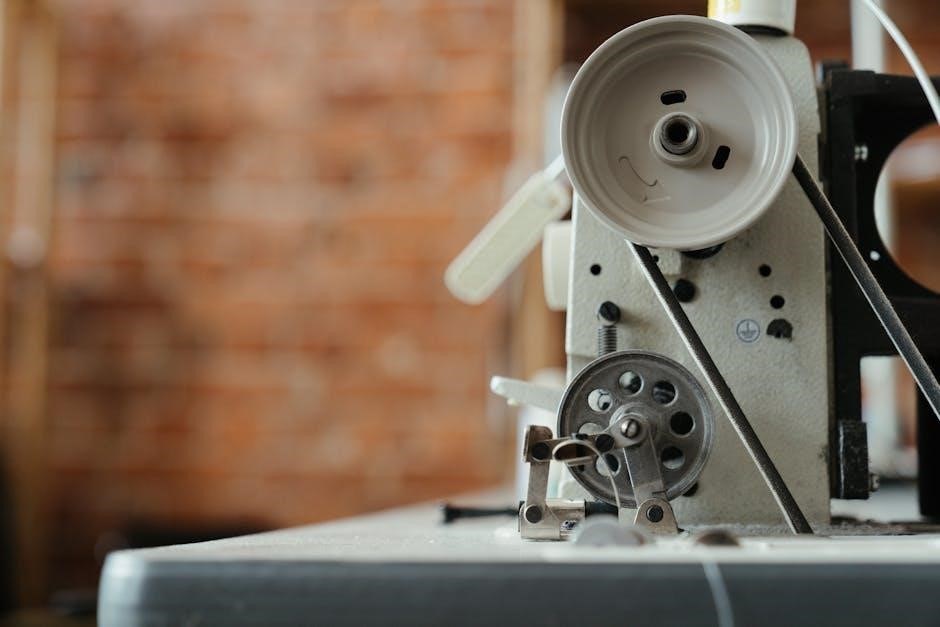
vintage sewing machine manuals
Vintage sewing machine manuals are timeless resources that provide detailed guidance for operating, maintaining, and troubleshooting classic machines, preserving their functionality and historical significance for enthusiasts and seamstresses alike.
1.1 Importance of Manuals for Vintage Sewing Machines
Vintage sewing machine manuals are essential for understanding the operation, maintenance, and repair of classic machines. They provide step-by-step instructions, troubleshooting tips, and guidance on stitch customization, ensuring optimal performance. These manuals also serve as historical documents, offering insights into the evolution of sewing technology and craftsmanship. For collectors and enthusiasts, they are invaluable resources for preserving the functionality and heritage of vintage machines, making them indispensable for both practical use and historical appreciation.
1.2 Brief History of Sewing Machine Manuals
Sewing machine manuals date back to the 19th century when manufacturers like Singer began producing guides to accompany their machines. Initially, these manuals were simple, focusing on basic operation and maintenance. As technology advanced, manuals evolved to include detailed instructions for various stitch types, troubleshooting, and parts replacement. By the mid-20th century, manuals became comprehensive resources, reflecting the complexity of modern sewing machines. Today, vintage manuals are sought after by collectors and enthusiasts, offering a glimpse into the history of sewing technology and the craftsmanship of earlier eras.

Popular Brands and Their Manuals
Singer, Husqvarna Viking, and Kenmore are iconic brands with vintage sewing machine manuals that provide detailed instructions for operation, maintenance, and troubleshooting, cherished by collectors and enthusiasts.
2.1 Singer Sewing Machine Manuals
Singer sewing machine manuals are highly sought after for their detailed instructions and historical significance. Models like the Featherweight 221 and 301A are prized by collectors, with manuals offering step-by-step guides for operation, maintenance, and troubleshooting. These manuals often include diagrams and repair tips, making them indispensable for restoring and using vintage Singer machines. Available in both free downloadable formats and paid resources, Singer manuals are a cornerstone for enthusiasts and professionals alike, ensuring the longevity of these iconic machines. Their comprehensive nature has cemented their place as essential tools in the world of vintage sewing.
2.2 Husqvarna Viking Sewing Machine Manuals
Husqvarna Viking sewing machine manuals are renowned for their clarity and depth, offering detailed guidance for models like the Class 71 Rotary Electric. These manuals provide comprehensive instructions for setup, maintenance, and troubleshooting, ensuring optimal performance. Available as free downloads or paid resources, they cater to both enthusiasts and professionals. The manuals often include diagrams and step-by-step repair guides, making them invaluable for vintage machine restoration. With a strong focus on stitch capabilities and performance, Husqvarna Viking manuals are a must-have for anyone aiming to preserve and utilize these iconic machines effectively.
2.3 Kenmore Sewing Machine Manuals
Kenmore sewing machine manuals are essential resources for operating and maintaining vintage Kenmore models. Available for specific models like the 385-1764180 and the Canadian Piedmont Zig Zag, these manuals offer detailed instructions for threading, maintenance, and troubleshooting. They often include diagrams and repair guides, making them invaluable for enthusiasts. Many Kenmore manuals are available as free downloads or paid resources, catering to collectors and restorers. These guides ensure the longevity and functionality of Kenmore machines, preserving their legacy as reliable and durable sewing companions for generations of sewists and crafters alike.
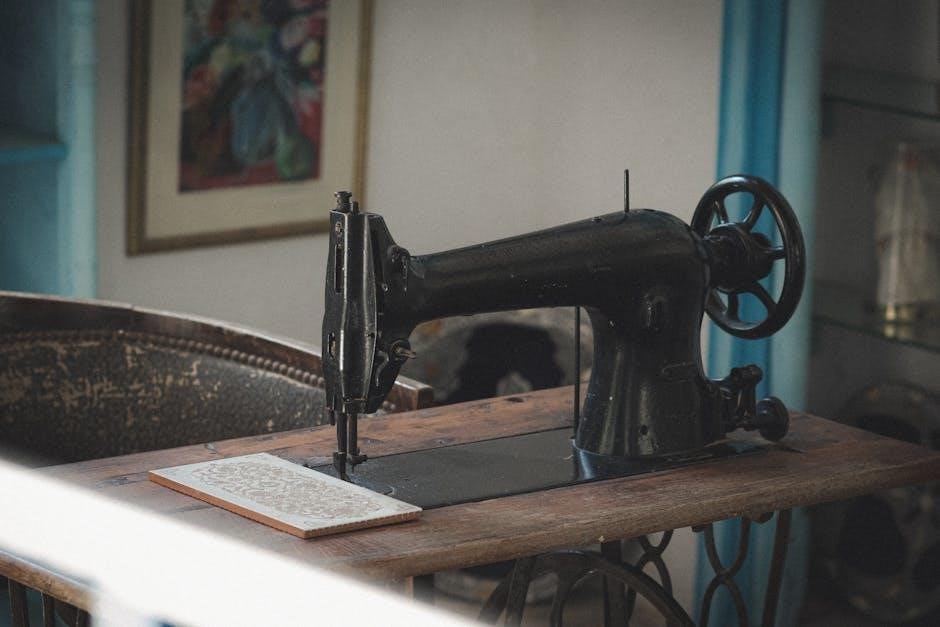
Key Features of Vintage Sewing Machine Manuals
Vintage sewing machine manuals offer detailed instructions, maintenance guides, stitch type capabilities, troubleshooting tips, and historical insights, ensuring the preservation and optimal use of classic machines.
3.1 Detailed Step-by-Step Instructions
Vintage sewing machine manuals provide comprehensive, easy-to-follow guides for setting up and operating classic machines. From threading the needle to managing the bobbin, these manuals ensure seamless functionality. They often include diagrams and detailed descriptions, making complex tasks accessible to both novice and experienced users. Instructions on selecting stitch types, adjusting tension, and performing routine maintenance are common, ensuring optimal performance; These step-by-step guides empower users to master their machines, whether for repairing garments or creating intricate designs. Their clarity and precision make them indispensable for preserving the usability and charm of vintage sewing machines.
3.2 Maintenance and Troubleshooting Guides
Vintage sewing machine manuals include essential maintenance and troubleshooting sections, ensuring longevity and functionality. They outline cleaning procedures, oiling techniques, and part replacement tips, helping users prevent mechanical issues. Troubleshooting guides address common problems like thread tension, jammed bobbins, and needle breakage, offering practical solutions. These sections empower users to diagnose and resolve issues independently, preserving their machines’ performance and extending their lifespan. By following these guides, enthusiasts can maintain their vintage sewing machines in optimal condition, ensuring they remain reliable and efficient for years to come.
3.3 Stitch Type Capabilities and Performance
Vintage sewing machine manuals highlight the stitch type capabilities and performance of each model, showcasing their versatility and craftsmanship. These guides detail various stitch patterns, from basic straight and zigzag stitches to intricate decorative options. They often include illustrations and charts to demonstrate stitch lengths and widths, helping users achieve professional results. Additionally, manuals provide insights into the machines’ performance, such as speed settings and fabric compatibility, enabling users to optimize their sewing experience. This information ensures that users can fully utilize their machine’s potential, whether for everyday projects or elaborate creations.
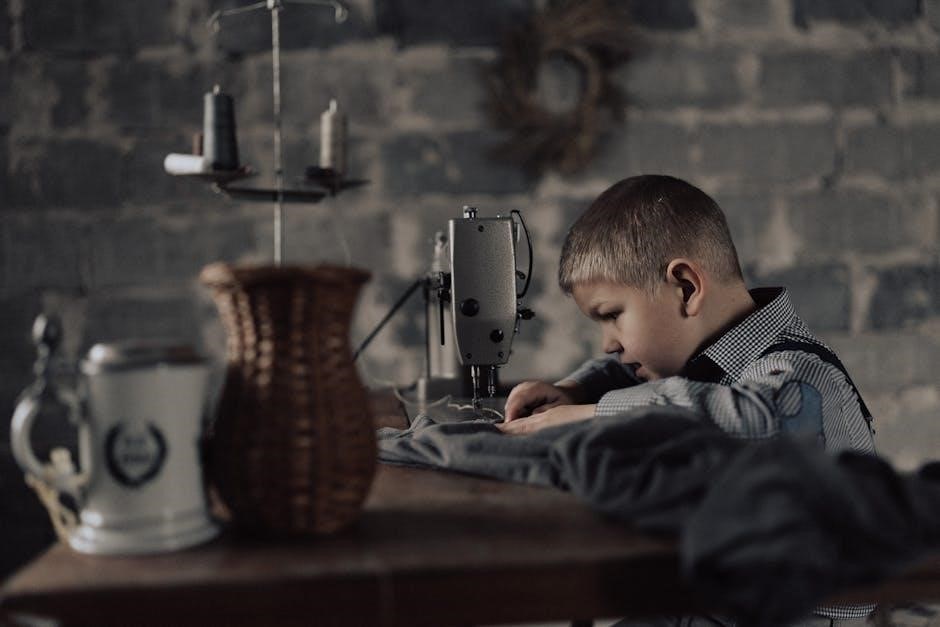
How to Use a Vintage Sewing Machine Manual
Using a vintage sewing machine manual is essential for understanding your machine’s operations and maximizing its potential. It provides step-by-step guides for threading, tension adjustment, and troubleshooting common issues, ensuring optimal performance and longevity of your vintage machine.
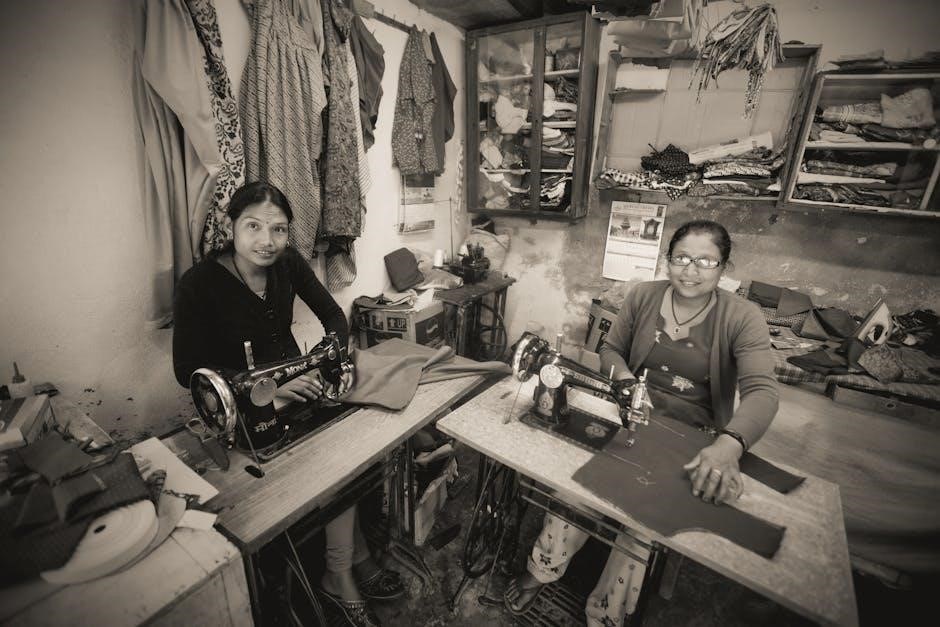
4.1 Threading and Bobbin Management
Threading and bobbin management are crucial steps in using a vintage sewing machine. Manuals provide clear, step-by-step guidance on how to properly thread the machine, ensuring the thread runs anti-clockwise from the spool. They also detail how to insert and manage the bobbin, emphasizing the importance of correct placement to maintain even stitch tension. Proper threading and bobbin setup are essential for smooth operation, preventing jams and ensuring consistent stitch quality. By following these instructions, users can master the fundamentals of vintage sewing machine usage, unlocking their full creative potential while preserving the machine’s functionality and longevity.
4.2 Adjusting Thread Tension
Adjusting thread tension is a critical aspect of using vintage sewing machines, ensuring balanced stitches and preventing fabric puckering or loose threading. Manuals provide detailed instructions for tweaking both the upper and bobbin thread tension dials to achieve the perfect alignment. Proper tension adjustment is essential for maintaining consistent stitch quality and avoiding common issues like thread breakage or uneven sewing. By following the manual’s guidance, users can fine-tune their machine’s tension settings, optimizing performance for various fabrics and projects. This step is vital for both novice sewists and experienced enthusiasts to unlock their machine’s full potential.
4.3 Solving Common Issues
Vintage sewing machine manuals often include troubleshooting guides to address common problems like thread jams, uneven stitching, or bobbin issues. These manuals provide step-by-step solutions, such as checking thread tension, clearing lint, or adjusting the needle position. For instance, if fabric isn’t feeding smoothly, the manual might suggest inspecting the feed dogs or ensuring proper presser foot alignment. Additionally, they may offer tips for diagnosing issues like inconsistent stitch length or skipped stitches, helping users identify whether the problem lies with the needle, bobbin, or thread quality. By following these troubleshooting steps, users can restore their machine’s performance and extend its lifespan.

Restoration and Maintenance Tips
Cleaning, oiling, and replacing worn parts are essential for restoring vintage sewing machines. Regular maintenance ensures optimal performance and preserves their historical charm for future generations.
5.1 Cleaning and Oiling Vintage Machines
Cleaning and oiling are crucial for maintaining vintage sewing machines. Use a soft brush to remove dust and debris from the machine’s housing and mechanical parts. Apply high-quality sewing machine oil to moving components, ensuring smooth operation. Regular lubrication prevents rust and wear, while thorough cleaning preserves the machine’s aesthetic and functional integrity. Always refer to the manual for specific oiling points and cleaning techniques. Proper maintenance not only extends the machine’s life but also enhances its performance, allowing it to function like new for generations to come.
5.2 Replacing Parts and Repairing Damaged Components
Replacing parts and repairing damaged components is essential for restoring vintage sewing machines to optimal functionality. Identify worn or damaged parts, such as gears, belts, or needles, and source compatible replacements from vintage suppliers or online marketplaces. Use the manual to guide disassembly and reassembly processes. For intricate repairs, consider consulting professional restorers who specialize in vintage machinery. Precision and care are vital to ensure components fit seamlessly and function correctly. Regular maintenance and timely repairs preserve the machine’s longevity and performance, allowing it to remain a reliable tool for sewing enthusiasts and collectors alike.
5.3 Professional Restoration Services
Professional restoration services offer expert care for vintage sewing machines. Skilled technicians meticulously clean, oil, and repair components, ensuring machines function like new. They specialize in rare models, preserving historical integrity. Many restorers provide detailed before-and-after demonstrations. Services include replacing obsolete parts and refinishing exteriors. Enthusiasts seeking flawless performance often rely on these professionals. Their work extends machine lifespan, making them usable for generations. Restoration not only revives functionality but also enhances aesthetic appeal, making vintage machines cherished possessions for sewists and collectors. These services are invaluable for maintaining sewing heritage and ensuring timeless craftsmanship endures.

Where to Find Vintage Sewing Machine Manuals
Vintage sewing machine manuals can be found online through free downloads, paid resources, and communities. Websites offer manuals for Singer, Husqvarna Viking, and Kenmore models, catering to enthusiasts.
6.1 Free Downloadable Manuals Online
Free downloadable manuals for vintage sewing machines are widely available online. Websites offer PDF manuals for models like Singer Featherweight 221, Kenmore 385, and Husqvarna Viking Class 71. These resources provide detailed instructions for setup, maintenance, and troubleshooting. Enthusiasts can access guides for threading, tension adjustment, and stitch capabilities. Platforms like Singer, PFAFF, and Husqvarna Viking host these manuals, catering to both beginners and experienced users. Additionally, sewing communities and forums share these manuals, fostering a culture of preservation and knowledge exchange among vintage sewing machine enthusiasts.
6.2 Paid Resources and Manuals
Paid resources offer high-quality, detailed manuals for vintage sewing machines, often scanned or reproduced from original documents. Sites provide manuals for specific models, such as Singer, Kenmore, and Husqvarna Viking, ensuring clarity and usability. These paid manuals are ideal for serious collectors or those needing precise instructions. Some platforms also offer deluxe editions with additional historical content, enhancing the value for enthusiasts. While free options exist, paid resources often deliver superior quality, making them a worthwhile investment for those seeking comprehensive guides to maintain and operate their vintage machines effectively.
6.3 Communities and Forums for Manual Sharing
Online communities and forums dedicated to vintage sewing machines serve as vibrant hubs for manual sharing and knowledge exchange. Enthusiasts often upload rare manuals, while others share repair tips and troubleshooting advice. Groups like the Vintage Stitchers Family of Groups and specialized forums foster collaboration, allowing members to access hard-to-find resources. These platforms also host discussions about machine restoration and maintenance, creating a supportive environment for collectors and hobbyists. By sharing manuals and expertise, these communities help preserve the legacy of vintage sewing machines, ensuring their continued use and appreciation for future generations.
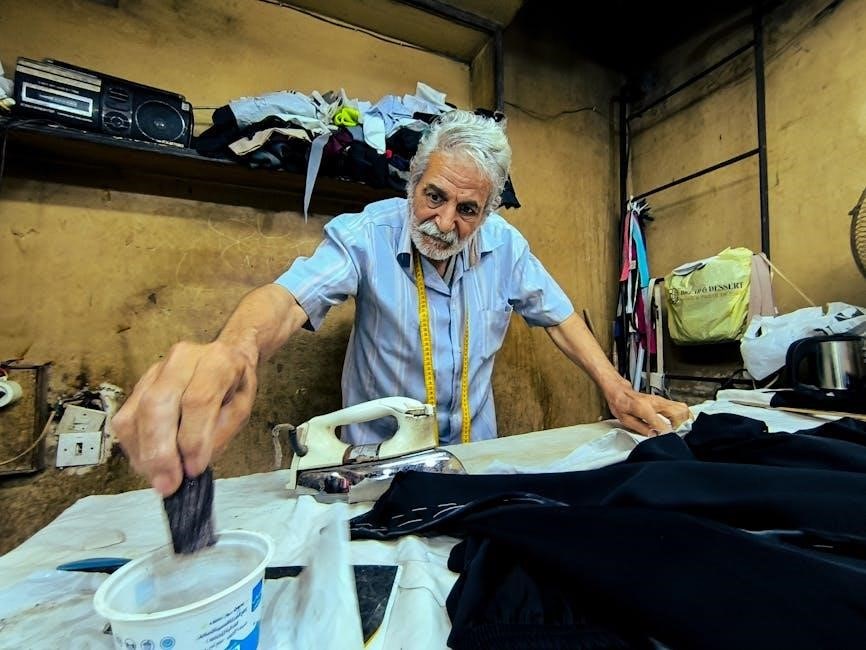
The Charm of Vintage Sewing Machines
Vintage sewing machines captivate enthusiasts with their timeless beauty, durability, and nostalgic appeal, inspiring creativity and evoking memories of a bygone era through their elegant design and functionality.
7.1 Aesthetic Appeal and Durability
Vintage sewing machines are admired for their stunning design, intricate details, and robust construction, making them both functional and decorative pieces. Their metal bodies and classic finishes exude timeless elegance, while their durability ensures they remain operational for decades. Unlike modern plastic machines, vintage models often feature craftsmanship that withstands the test of time. The aesthetic appeal of these machines lies in their nostalgic charm, evoking memories of past eras. For many, their beauty is not just in their appearance but also in their ability to inspire creativity and connect generations through shared sewing experiences and family heirlooms.
7.2 Inspirational Demonstrations and Projects
Vintage sewing machine manuals often feature step-by-step guides for creating intricate stitches and patterns, inspiring users to experiment with various fabrics and techniques. These manuals showcase the creative potential of vintage machines, encouraging projects like embroidery, quilting, and home decor. Demonstrations highlight the machines’ versatility, proving they can handle both delicate and heavy-duty tasks. Enthusiasts and seamstresses find motivation in these guides, which not only provide technical instructions but also spark imagination for unique sewing initiatives. The combination of historical craftsmanship and modern creativity makes these machines a timeless tool for artistic expression and practical craftmanship.
7.3 Nostalgia and Historical Value
Vintage sewing machine manuals evoke a deep sense of nostalgia, connecting users to the past and the evolution of sewing technology. These manuals often serve as historical artifacts, detailing the craftsmanship and innovation of bygone eras. For many, they represent a tangible link to ancestors who relied on these machines for everyday needs. The durability and aesthetic appeal of vintage machines further enhance their historical significance, making them cherished family heirlooms. Preserving these manuals ensures the legacy of early sewing innovations, offering a window into the lives of previous generations and the cultural importance of sewing as a practical and creative art form.
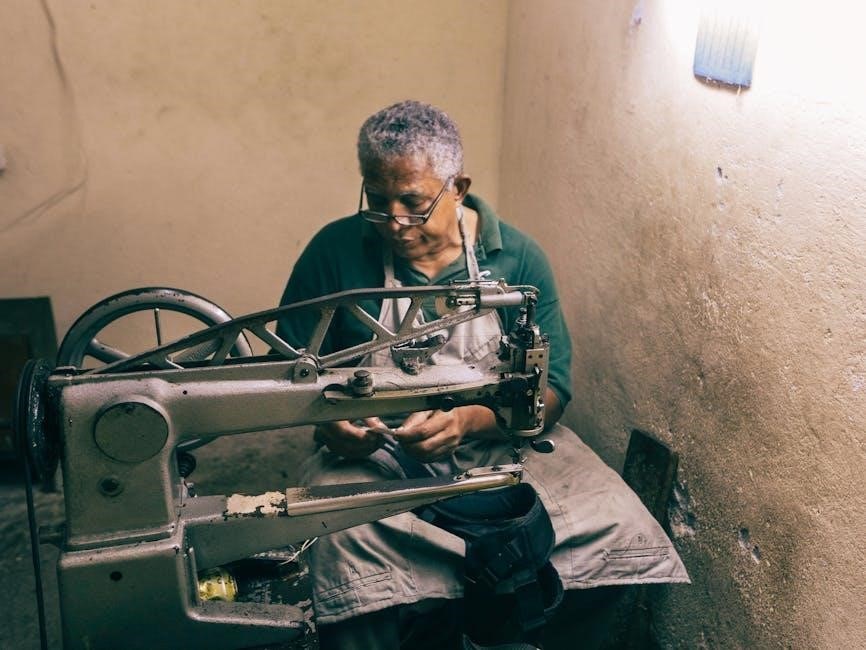
DIY Projects with Vintage Sewing Machines
Vintage sewing machines inspire creative DIY projects, from upcycling into functional decor to repurposing parts for unique crafts, fostering innovation and preserving their historical charm.
8;1 Upcycling and Repurposing Old Machines
Upcycling vintage sewing machines offers a creative way to preserve their historical charm while giving them new life. Enthusiasts can transform these machines into functional decor, such as side tables, lamps, or wall art. Repurposing parts like gears and bobbins into jewelry or sculptures adds an artistic touch. Even non-functional machines can be restored for display or integrated into unique furniture designs. This practice not only reduces waste but also honors the craftsmanship of these timeless devices, making them a focal point in modern spaces while celebrating their legacy in sewing history.
8.2 Customizing Your Vintage Sewing Machine
Customizing a vintage sewing machine allows enthusiasts to add a personal touch while maintaining its functionality. Owners can repaint the exterior, add decorative decals, or even replace hardware for a modern look. Upgrading parts, such as swapping metal components for vintage-look alternatives, can enhance both aesthetics and performance. Manuals often provide insights into compatible modifications. Additionally, enthusiasts can install custom stitching patterns or attach embroidery accessories for specialized projects. These creative tweaks not only preserve the machine’s heritage but also make it a one-of-a-kind tool for sewing enthusiasts and collectors alike, blending tradition with personal style.
8.3 Creative Sewing Projects Using Vintage Machines
Vintage sewing machines offer a unique charm for creative projects, blending nostalgia with practicality. Enthusiasts can craft custom embroidery, quilts, or upcycled home decor, leveraging the machine’s distinct stitch capabilities. Despite limited electronic features, these machines excel at precise, durable stitching, making them ideal for heirloom-quality creations. Many users share inspirational demonstrations online, showcasing how vintage machines can produce intricate designs. Whether restoring a family heirloom or creating modern pieces, vintage sewing machines inspire a connection to the past while bringing personal visions to life through timeless craftsmanship and artistic expression.

Collecting Vintage Sewing Machine Manuals
Collecting vintage sewing machine manuals is a rewarding hobby, offering insights into historical craftsmanship and practical guidance for restoring and operating classic machines with precision and care.
9.1 Rare and Valuable Manuals
Rare and valuable vintage sewing machine manuals are highly sought after by collectors, offering a glimpse into the history of sewing technology. These manuals, often featuring detailed illustrations and step-by-step instructions, can significantly enhance the value of a vintage machine. Some rare models, like early Singer Featherweight manuals, are particularly prized. Collectors should look for manuals in good condition, with all pages intact and minimal wear. Online marketplaces and specialized forums are great resources for finding these treasures, which not only serve practical purposes but also hold sentimental and historical worth.
9.2 Organizing and Storing Your Manual Collection
Organizing and storing your vintage sewing machine manual collection requires careful consideration to preserve their condition and accessibility. Bind manuals in protective covers or store them in acid-free folders to prevent deterioration. Digital backups are also recommended for easy access and sharing. Keep manuals in a cool, dry place, away from direct sunlight and moisture. Consider categorizing them by brand or model for easier reference. Proper storage ensures your collection remains intact for future generations of sewing enthusiasts, while also maintaining its historical and practical value.
9.3 The Role of Manuals in Preserving Sewing History
Vintage sewing machine manuals play a vital role in preserving sewing history by documenting the evolution of sewing technology and techniques. These manuals serve as historical records, detailing the development of various models, their features, and usage. They provide insights into the innovations of iconic brands like Singer and Husqvarna Viking, showcasing how sewing machines transformed over time. Manuals also highlight the cultural and practical significance of sewing, offering a window into the past for historians and enthusiasts. By preserving these manuals, we honor the legacy of sewing craftsmanship and ensure its continuation for future generations.
Vintage sewing machine manuals are essential for preserving historical sewing practices, offering detailed insights and guidance that inspire and educate enthusiasts, ensuring timeless craftsmanship endures.
10.1 The Timeless Value of Vintage Sewing Machine Manuals
Vintage sewing machine manuals hold immense value as they provide comprehensive guidance for maintaining and operating antique machines. These documents are not just instructional tools but also historical artifacts that reveal the evolution of sewing technology. Enthusiasts and collectors cherish them for their detailed step-by-step instructions, troubleshooting tips, and insights into the craftsmanship of bygone eras. Beyond practical use, they serve as a bridge between past and present, preserving the legacy of sewing and inspiring future generations to appreciate the art of traditional sewing.
10.2 Encouraging the Preservation of Sewing Heritage
Preserving sewing heritage involves safeguarding vintage sewing machine manuals, which are vital for understanding and maintaining antique machines. These manuals educate users about historical sewing techniques and promote the appreciation of craftsmanship. Communities and forums dedicated to vintage sewing machines play a crucial role in sharing knowledge and resources. By encouraging the restoration and use of these machines, enthusiasts help keep the legacy of sewing alive. Professional restorers and hobbyists alike contribute to this effort, ensuring that the art of traditional sewing endures for future generations to cherish and utilize.